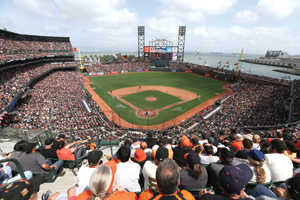For years, we as American sports architects have approached facility design with the goal of creating iconic, recognizable structures, the result of both client directive and the culture within our industry.
“Iconic” has become a buzzword of team owners and client-side leaders as well as sports architects, and it’s easy to see why. Elected leaders set out to deliver eye-popping buildings to visibly assure and remind citizens that their significant public dollars went toward something that appears meaningful. Deep-pocketed team owners who go it alone without public subsidies often strive to be the biggest and/or most outrageous. Similar sentiment prevails on university campuses. We’re all guilty of having strived for iconic when it comes to sports facilities.
At the same time, many designers tout the urban integration of their facility designs. But can we achieve both?
Consider the most recent crop of design solutions: Minnesota Vikings, Atlanta Falcons, Golden State Warriors, even Basra, Iraq (security issues aside). The Chris Hansen-led Seattle arena proposal looked to be the brightest opportunity for a well-integrated urban design solution in years. Yet all too often, our “iconic” building goal overrides all and results in facilities that look more like UFO landings with little connection to the surrounding urban fabric.
In our new, reset economy, there’s simply far too much money invested in these buildings to suggest a mere 30-year life span. Think Metrodome, or Edward Jones Dome. Setting aside the failed multipurpose aspect, these stadiums were icons at the time, but their relevancy wasn’t as lasting as it could have been. Today, taxpayers demand far more. Likewise, donors and private investors will demand more from their investments.
So what to do? We design architects hold significant power to shape opinions and tastes of society at large while allocating millions of dollars with each pen stroke. We also must remind ourselves of our obligation to help repair cities and communities. To that end, we should apply pressure and influence elected officials and team owners to integrate their facilities into the urban fabric rather than separating it with a standoffish, “look-at-me” presence. As designers, we need to demand more of ourselves.
Consider this alternative: Given the substantial footprint of sports facilities, often one end is literally in a different neighborhood than the opposite end. Instead of a single, massive architectural gesture that spans multiple neighborhoods, think of organizing the exterior to relate to these unique neighborhoods, each with its own entry, food, amenities and overall experience. As fans traverse the building, the experience of different neighborhoods is directly reflected inside, lending a continuous experience all the way to their seats that feels authentic over showy. As for concerns about staffing multiple entries, advancements in ticketing technologies can alleviate these issues.
Another solution is to take program elements and make them work in two directions. During event time, a concession or toilet supports the concourses. During pre-event or potentially non-event times, those same toilets, concessions and restaurants shutter the concourse access and open to the street. True and real integration into the urban fabric.
When we make fundamental shifts in executing the program, the building’s success is not in being an often unapproachable sculptural object surrounded by windswept plazas and subject to ever-changing taste. Rather, it becomes a blur of seamless architectural experiences — from local pubs to pedestrian-oriented streets to retail, team store and seating bowl.
 |
Each side of San Francisco’s AT&T Park responds to its unique urban environment.
Photo by: GETTY IMAGES |
This is how we create authentic architecture unique to its time and place. Start with designing user experiences rather than forcing large, iconic architectural gestures that will date the building “2013” for the rest of its life span.
AT&T Park in San Francisco is a great example of a facility integrating seamlessly into its environment. On the urban, street side, restaurants and a team store line the street. On the bay side, promenades, parks and, of course, the ability to catch a home run while in a boat make it pretty special. Each side of the stadium responds to its unique environment.
Likewise, when considering a renovation, observe how the facility can relate to the neighborhood, integrating the local culture and business community. For example, the inside action was extended to the street in the renovation of Jeld-Wen Field for the Portland Timbers. Passers-by can see into the stadium right at the location of an integrated light rail stop. Regionally sourced materials were designed into the project in a community that fully embraces sustainability. Elsewhere, in designing the Minnesota Wild’s new Bud Light Top Shelf Lounge, we used a classic wooden boat theme unique to the Minnesota lifestyle that integrates a slew of architectural products from 3M, a familiar Twin Cities corporate citizen. Fans relate and connect because the design is local, authentic and meaningful.
Framing it another way, consider the purchasing decisions of current and future season-ticket holders and corporate decision-makers — the millennials. These adults, currently ages 18-35, do not strive for showy purchases or buy big-ticket items like cars, homes and appliances. They engage in collaborative consumption, sharing with peers, and place enormous value on authenticity. Luxury is about experience, not stuff, and home is a place to live out of, not live in. They time-share everything (including cars and housing), focusing on the holistic experience rather than the prestige of showiness or status. How does your facility relate to this?
Less focus on iconic design solutions and more time spent integrating the local urban fabric and business community will result in a greater return on investment for stakeholders; authentic experiences for users; and neighborhood stabilization for the community, ultimately creating those elusive jobs we promise to create. When the facility becomes ingrained in the hearts of community members by delivering a real, local experience, the cradle-to-grave pro forma goes from 30 years to 100 years.
Want an example? Look no further than Fenway Park.
Tom Proebstle (tom@generatorstudio.com) is founder and design director of Generator Studio, a Kansas City-based architecture firm. His previous work includes a 2003 master plan for Fenway Park.





